中国经济管理大学_MBA课件《供应链管理》学员问题探讨与案例分析_(
- 格式:pdf
- 大小:542.24 KB
- 文档页数:37

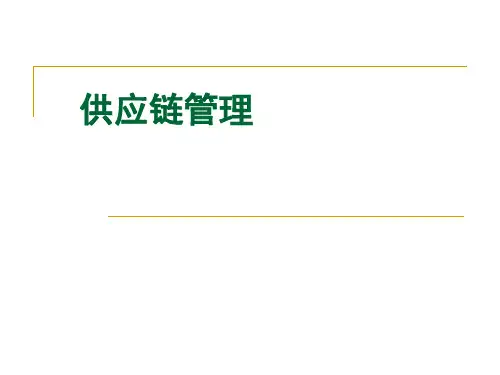
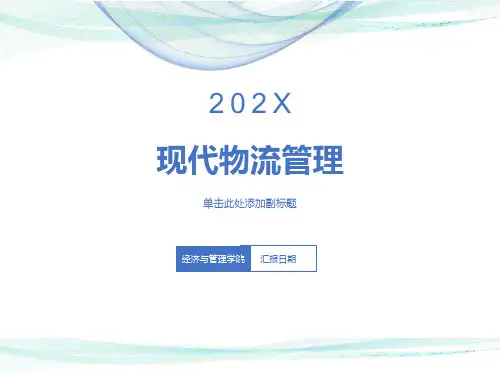
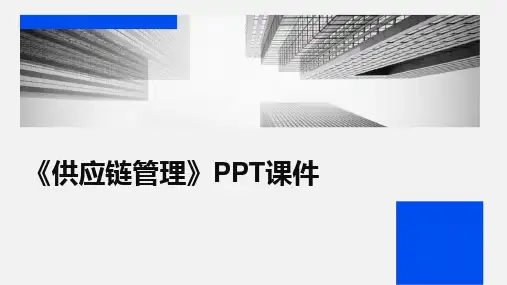

•供应链管理概述•供应链战略规划与设计•采购与供应商管理•库存管理与控制•运输与配送管理•信息技术在供应链管理中的应用•绿色供应链与可持续发展•总结回顾与展望未来发展目录01供应链管理概述供应链定义与构成供应链定义供应链构成供应链管理的目标是在满足客户需要的前提下,对整个供应链(从供货商,制造商,分销商到消费者)的各个环节进行综合管理,例如从采购、物料管理、生产、配送、营销到消费者的整个供应链的货物流、信息流和资金流,把物流与库存成本降到最小。
管理原则供应链管理就是指对整个供应链系统进行计划、协调、操作、控制和优化的各种活动和过程,其目标是要将顾客所需的正确的产品(Right Product)能够在正确的时间(Right Time)、按照正确的数量(Right Quantity)、正确的质量(Right Quality)和正确的状态(Right Status)送到正确的地点(Right Place),并使总成本达到最佳化。
管理目标供应链管理目标与原则VS供应链类型及特点类型特点02供应链战略规划与设计1 2 3确定供应链战略目标分析供应链环境评估供应链能力供应链战略分析供应链设计原则与方法供应链设计原则供应链设计方法供应链设计步骤供应链网络优化策略供应链网络优化目标01供应链网络优化方法02供应链网络优化实施0303采购与供应商管理采购策略制定及执行采购需求分析明确采购目标,分析市场需求和供应情况,制定采购计划。
采购方式选择根据采购物品的性质、数量和金额等因素,选择合适的采购方式,如招标、询价、竞争性谈判等。
采购合同执行签订采购合同,明确双方权利和义务,确保采购物品按时、按质、按量交付。
供应商选择与评价方法供应商初选供应商评价供应商选择供应商关系维护与发展供应商沟通供应商激励A B C D供应商支持供应商发展04库存管理与控制库存概念及分类方法库存定义库存分类库存控制策略与技术应用库存控制策略技术应用借助现代信息技术手段,如ERP、SCM等系统,实现库存信息的实时更新和共享,提高库存控制的准确性和时效性。
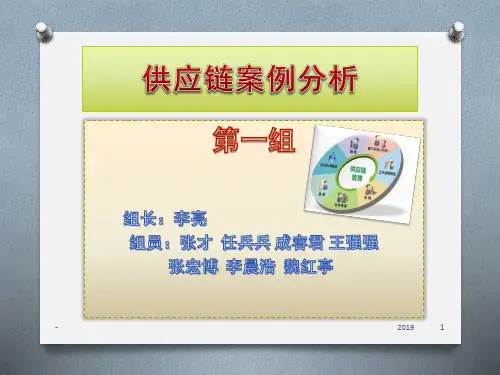
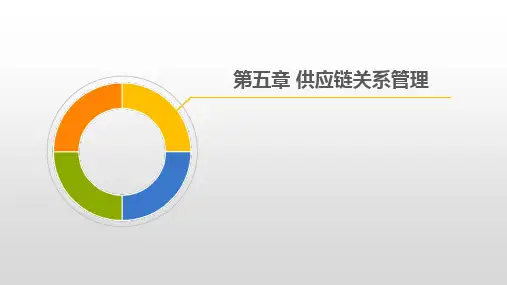
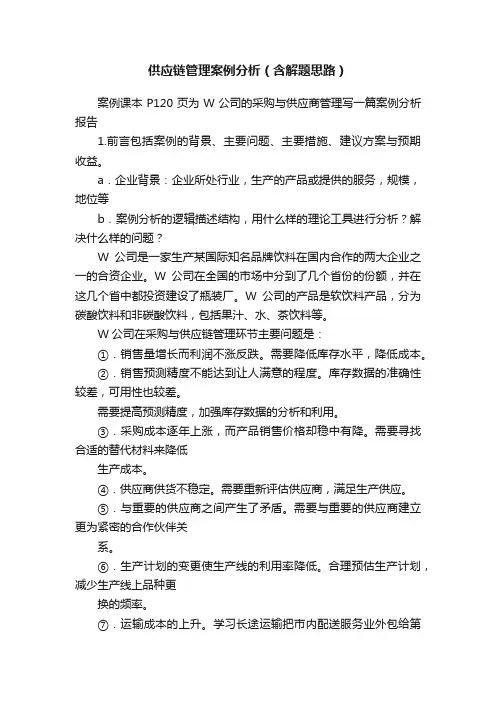
供应链管理案例分析(含解题思路)案例课本P120页为W公司的采购与供应商管理写一篇案例分析报告1.前言包括案例的背景、主要问题、主要措施、建议方案与预期收益。
a.企业背景:企业所处行业,生产的产品或提供的服务,规模,地位等b.案例分析的逻辑描述结构,用什么样的理论工具进行分析?解决什么样的问题?W公司是一家生产某国际知名品牌饮料在国内合作的两大企业之一的合资企业。
W公司在全国的市场中分到了几个省份的份额,并在这几个省中都投资建设了瓶装厂。
W公司的产品是软饮料产品,分为碳酸饮料和非碳酸饮料,包括果汁、水、茶饮料等。
W公司在采购与供应链管理环节主要问题是:①.销售量增长而利润不涨反跌。
需要降低库存水平,降低成本。
②.销售预测精度不能达到让人满意的程度。
库存数据的准确性较差,可用性也较差。
需要提高预测精度,加强库存数据的分析和利用。
③.采购成本逐年上涨,而产品销售价格却稳中有降。
需要寻找合适的替代材料来降低生产成本。
④.供应商供货不稳定。
需要重新评估供应商,满足生产供应。
⑤.与重要的供应商之间产生了矛盾。
需要与重要的供应商建立更为紧密的合作伙伴关系。
⑥.生产计划的变更使生产线的利用率降低。
合理预估生产计划,减少生产线上品种更换的频率。
⑦.运输成本的上升。
学习长途运输把市内配送服务业外包给第三方,控制车辆的线路安排与制定装载计划,合理安排运输线路。
⑧.绩效考核体系不健全,缺乏可比性。
可以对8个厂进行标杆管理。
2.现状描述(要求描述精确)a.企业遇到的问题【流程问题、效益问题、采购人员问题(岗位设置、权限、绩效)、供应商问题(供应商选择、绩效、关系)、采购商业环境、信息化工具的应用等】b.结合具体的分析工具,需求对所使用的理论分析工具进行阐述。
具体的采购常用理论分析工具:一.商业环境分析A.宏观环境PESTN模型政治,经济,社会文化,科学技术,自然环境B.中观环境a 波特五力模型竞争激烈程度、行业产品生命周期、供应商讨价还价能力、客户讨价还价能力、潜在进入者的威胁b SCP范式市场结构—市场行为—市场绩效C.微观环境SWOT分析优势劣势机遇挑战微观环境是指企业自身资源和能力,包括:企业的战略目标、市场营销能力、筹资和投资能力、市场响应度、生产水平和提供服务能力等方面。

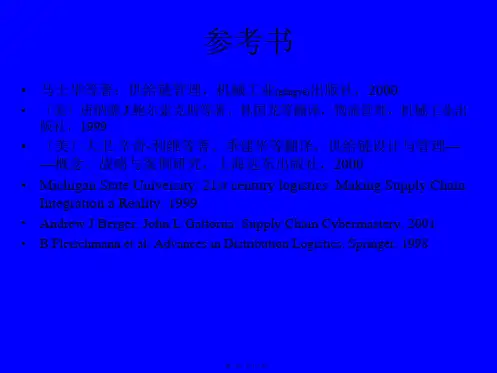

供应链管理完整ppt 课件目录•供应链管理概述•供应链战略规划•采购与供应商管理•库存管理与优化•运输与配送管理•信息技术在供应链管理中的应用•绿色供应链构建与实践•供应链管理挑战与对策01供应链管理概述成熟阶段引入信息技术和智能化手段,实现供应链的可视化、可预测和可优化。
定义供应链管理是一种集成化的管理思想和方法,它涵盖了从供应商到最终客户的整个供应链条上的物流、信息流和资金流的计划、组织、协调和控制。
初级阶段以企业内部物流管理为主,关注库存控制和运输效率。
发展阶段开始关注企业与供应商、客户之间的协同合作,强调供应链的整体优化。
定义与发展历程供应链结构与组成要素包括供应商、制造商、分销商、零售商和最终客户等节点,形成一个网状结构。
涉及原材料采购、生产、运输、仓储和配送等环节。
包括订单信息、库存信息、生产计划和销售数据等信息的传递和处理。
涉及采购付款、销售收款以及各环节之间的资金结算等。
供应链结构物流信息流资金流管理目标提高客户满意度和服务水平。
降低总成本,提高盈利能力。
优化资源配置,提高运营效率。
建立稳定的供应链合作关系,降低风险。
以客户为中心始终关注客户需求,提高客户满意度。
系统化思维从全局出发,优化整个供应链系统的性能。
信息共享与协同加强供应链各环节之间的信息沟通与协同合作。
持续改进与创新不断寻求改进机会,引入新技术和方法,推动供应链管理的创新发展。
02供应链战略规划确定供应链战略目标明确供应链战略与企业整体战略的关系,设定供应链管理的长期和短期目标。
分析供应链环境评估供应链所处的内外部环境,包括市场需求、竞争态势、政策法规、技术进步等。
识别供应链优势和劣势对企业自身和竞争对手的供应链能力进行深入分析,找出优势和劣势。
03制定供应链协同计划推动供应链上下游企业之间的协同合作,提高供应链的整体效率和响应速度。
01制定供应链战略基于战略分析结果,制定符合企业整体战略的供应链战略,明确供应链管理的发展方向和重点。
MBA-供应链管理课件 (一)MBA-供应链管理课件:深度解析供应链随着全球化的发展,越来越多的企业开始注重供应链管理。
在市场竞争愈加激烈的今天,优化供应链已经成为企业缩短交付周期、提升服务质量、降低成本、提高竞争力的重要手段。
MBA-供应链管理课件正是为了帮助学生深度了解供应链管理的实践方法、工具和策略,提升其与市场竞争相适应的能力而开设的。
一、课程设置MBA-供应链管理课件的教学内容主要包括以下四个方面:1.供应链基础知识:了解供应链的历史和发展、供应链的各种组成部分、供应链的各个环节的作用和相互影响,以及各种供应链管理方法和工具。
2.供应链战略规划:研究如何根据企业的经营战略和市场需求来制定合理的供应链战略,并学习供应链战略实施过程中面临的难点和如何解决。
3.供应链运营管理:发掘和梳理供应链环节中的运营流程、技术及工具,并研究其管理方法、评估及优化模型。
4.供应商与客户管理:研究如何建立良好的供应商和客户关系,提升企业在市场中的竞争力和营收。
二、课程特色MBA-供应链管理课程特色体现在以下几个方面:1.理论和实践相结合:课程理论知识较为丰富,每个章节都配备大量实例,同时也会对学生的实践操作进行较为详细的介绍。
2.强调案例解析:案例分析是课程的重点和难点。
不仅是国内供应链领域的典型案例,而且涉及到供应链上下游的所有产品与服务行业,这意味着学生可以从多角度、多情景下,重新认识自己所处的产业链条或行业。
3.与实际操作结合紧密:教材上所用的示例均来源于市场,涵盖了出现在国内工商、公共部门的问题和现象,与这些问题及环境,在实际工作中所要解决的问题十分相似。
三、课程价值MBA-供应链管理课程对于学生有着重要的价值:1.提高个人应用技能:在课程中实践训练与案例分析,让学生具备较高应用能力,运用理论模型解决实际问题。
2.追求绩效优化:课程内容是时下企业置身于实践中不断梳理与优化的供应链领域,对学生成为一个优秀供应链专业者有巨大促进作用。
中国经济管理大学MBA课件《供应链管理》学员问题探讨与案例分析(苏尼尔•乔普拉著教材)CHAPTER ONEDiscussion Questions1Consider the purchase of a can of soda at a convenience store. Describe the various stages in the supply chain and the different flows involved.When a customer purchases a can of soda at a convenience store, his purchase represents the end of a supply chain’s delivery of an item and the beginning of information regarding his purchase flowing in the opposite direction.The supply chain stages include customers, retailers, wholesalers/distributors, manufacturers, and component/raw material suppliers. A customer’s purchase moves product towards the customer and dollars and information towards the retailer.The retailer places an order from the wholesaler/distributor to replenish stock, thereby moving information back up the supply chain while moving product down the supply chain. As the order is filled, the retailer will move dollars back up the supply chain.The wholesaler/distributor transmits information and dollars to the manufacturer who produces product and ships it down the supply chain to the wholesaler.Finally (or initially, depending on your perspective) the manufacturer moves orders(information) and dollars towards suppliers in exchange for material flow into their production processes.2Why should a firm like Dell take into account total supply chain profitability when making decisions?Dell realizes that their ultimate success lies with the success of their supply chain and its ability to generate supply chain surplus. If Dell was to view supply chain operations as a zero sum game, they would lose their competitive edge as their suppliers’ businesses struggled. Dell’s profit gained at the expense of their supply chain partners would be short lived. Just as aphysical chain is only as strong as its weakest link, the supply chain can be successful only if all members cooperate and focus on a global optimum rather than many local optima.3What are some strategic planning and operational decisions that must be made by an apparel retailer like The Gap?As The Gap plans supply chain strategy it must first consider the marketing function’s pricing plans in order to structure a supply chain consonant with these plans. Strategic considerationssuch as the capacity of each supplier and assembly operations, sourcing decisions and how logistics are to be handled are all part of the design. The supply chain must also settle oncommunication channels and frequencies.Supply chain planning takes the strategic decisions as a given and seeks to exploit efficiencies in the chain to maximize supply chain surplus. The entire chain should collaborate inforecasting and planning production as to achieve a global optimum. The forecasts should take into account planned promotions and known seasonal fluctuations in demand.The operational decision take the plans as a given and make day-to-day decisions to process customer orders, allocate resources to certain customers, trigger orders from supply chainmembers, and deliver product.4Consider the supply chain involved when a customer purchases a book at a bookstore. Identify cycles in this supply chain and the location of the push/pull boundary.All supply chain processes can be broken down into four process cycles that connect the five stages of the supply chain; the customer order cycle, the replenishment cycle, the manufacturing cycle, and the procurement cycle.The customer order cycle connects the customer with the retailer; this connection is made as the book, perhaps Supply Chain Management by Chopra and Meindl, is selected and paid for by the customer.The replenishment cycle connects the retailer and the distributor and is triggered by theretailer’s need to fill the empty shel f space with another copy of this tome.The manufacturing cycle connects the distributor and the manufacturer. As demand for the book is realized and distributors empty their warehouses, they signal the manufacturer to printanother million copies to fill their empty warehouses.Finally, the procurement cycle connects the manufacturer and the supplier. The manufacturer requires raw material inputs of paper, ink, etc., to begin the assembly process for another batch of Supply Chain Management.The push/pull boundary exists where demand switches from reactive (pull) to speculative (push) production. For most bookstore supply chains the push/pull boundary is between the customer order cycle and the replenishment cycle. The customer order pulls the book from the book store shelf but the initial production of the book was triggered by a build order that moved materials along the supply chain to the retail outlet.5Consider the supply chain involved when a customer orders a book from Amazon. Identify the push/pull boundary and two processes each in the push and pull phases.In Amazon’s original operations design the push/pull boundary existed betwixt the retailer (Amazon) and their distributor. Amazon ordered product from the distributor and the customer order arrived. Today, Amazon has six warehouses where it stocks an inventory of items it is confident that will sell. In this scenario, the push/pull boundary exists between the customer and the retailer.Processes in the pull phase are the order fulfillment, shipping, customer returns, and customer billing. Processes in the push phase are production, stock replenishments, shipping, andpayment.6In what way do supply chain flows affect the success or failure of a firm like Amazon? List two supply chain decisions that have a significant impact on supply chain profitability.The success or failure of a company like Amazon is decided by the effective function of its supply chain. The flow of products from publishers to distributors to customers must be rapid and reliable in order to satisfy customers. The flow of information back through the supplychain allows all members to coordinate efforts. The flow of money allows all supply chain members to maintain operations. Supply chain profitability is influenced by sourcing,promotion, and fulfillment decisions.CHAPTER TWODiscussion Questions1.How would you characterize the competitive strategy of a high-end department store chain suchas Nordstrom? What are the key customer needs that Nordstrom aims to fill?The Nordstrom web site states the following. Over the years, the Nordstrom family ofemployees built a thriving business on the principles of quality, value, selection, and service.Today, Nordstrom is one of the nation’s leading fashion retailers, offering a wide variety of high-quality apparel, shoes, and accessories for men, women, and children at stores across the country. We remain committed to the simple idea our company was founded on, earning the trust of our customers one at a time.Nordstrom fills customer needs for high quality fashion merchandise and outstanding levels of customer service. Price is no object for the typical Nordstrom shopper.2.Where would you place the demand faced by Nordstrom on the implied demand uncertaintyspectrum? Why?Implied demand uncertainty is demand uncertainty due to the portion of demand that the supply chain is targeting, not the entire demand. A high-end department store chain such as Nordstrom falls on the high end of the implied demand uncertainty scale. The fashion items that Nordstrom stocks have extremely high product margin, high forecast errors and stockout rates, and once the season is over, these items are sold at deep discounts at their Nordstrom Rack outlet stores.3.What level of responsiveness would be most appropriate for Nordstrom’s supply chain? Whatshould the supply chain be able to do particularly well?Supply chain responsiveness takes many forms, including the ability to respond to a wide range of quantities, meet short lead times, handle a large variety of products, build innovativeproducts, meet a high service level, and handle supply uncertainty. The Nordstrom supply chain must be highly responsive in the areas of handling highly innovative fashion products, customer response, and service level; they are effective in supplying well-heeled customers withmerchandise and their return policy is legendary in the Pacific Northwest.4.How can Nordstrom expand the scope of the strategic fit across the supply chain?Scope of strategic fit refers to the functions within the firm and stages across the supply chain that devise an integrated strategy with a shared objective. By adopting an intercompanyinterfunctional scope strategy, Nordstrom will maximize supply chain surplus. Nordstrom can move in this direction by working with their suppliers as if they are actually owned byNordstrom. Rather than viewing the supply chain as a zero-sum game of inventory costminimization and profit maximization, Nordstrom must recognize that spreading the wealth and occasionally taking on more inventory than is optimal for them will result in improved customer service. The intercompany interfunctional scope of strategic fit requires more effort than the other approaches presented in this section; Nordstrom must evaluate all aspects of their supply web.5.Reconsider the previous four questions for other companies such as Amazon, a supermarketchain, and auto manufacturer, and a discount retailer such as Wal-Mart.Amazon focuses on cost and flexibility by providing books, music and a host of otherhousehold products at low prices. Customers place orders online and expect to receivepurchases in a number of days. Customer orders are processed at central warehouses or are drop shipped from suppliers by mail or common carrier. For the most part, the implied demand uncertainty for Amazon is low as th ey cast such a wide net. Amazon’s supply chain must be responsive in terms of flexibility; they handle an incredibly diverse range of products.Amazons supply chain should be able to provide low prices wide variety and reasonabledelivery schedules for its customers. In every link of the supply chain, Amazon must function on the cost-responsiveness efficient frontier in order to support its competitive strategy.A supermarket chain focuses on cost and quality, with some specialty chains adding flexibilityby carrying a broader range of products that may be targeted towards customers interested in organic products or ethnic cuisine. Implied demand uncertainty for a supermarket chain tends to be low; shoppers are typically repeat customers and have a constant demand level. Thesupermarket supply chain must be responsive by receiving produce quickly to ensure freshness and have a high service level. Supermarket supply chains tend to be well-established and can improve strategic fit by emphasizing speed to maintain freshness, hence perceived quality.Auto manufacturers have extremely complicated supply chains that are increasingly focused on flexibility and lean operations. Implied demand uncertainty for auto manufacturers variesconsiderably by target market and manufacturer. Automotive supply chains among the big three in the United States have made great progress in the last decade and recognize that they must be responsive from a time and flexibility standpoint.Wal-Mart’s supply chain is obsessed with co st and is facilitated by a low implied demanduncertainty, their impressive logistics system and their management information systems. Their supply chain is able to respond quickly to fill a wide variety of products to keep merchandise on Wal-Mart’s shelve s. Wal-Mart’s level of coordination along the supply chain is excellent; it would be difficult to point out areas where true intercompany interfunctional scope of strategic fit has not been achieved. The sole supply chain criticism that surfaces is an occasional report that suppliers feel as if supply chain surplus is not shared equitably.6.Give arguments to support the statement that Wal-Mart has achieved very good strategic fitbetween its competitive and supply chain strategies.The best argument to support the statement that Wal-Mart has achieved very good strategic fit is their success as a company. Competition today is supply chain versus supply chain, notcompany versus company, so a company’s partners in the supply chain often determine the company’s success.Wal-Mart’s strategic focus on cost is evident in their competitive, product development, supply chain, and marketing strategy. Their marketing strategy of advertising every day low prices appeals to consumers and does not disrupt the supply chain by causing surges in demand.Visiting one of their big box stores reveals low-priced merchandise, both national and store brands, stacked from floor to ceiling without elaborate displays or decoration. Wal-Mart’s logistics and information systems are famous for coordinating their entire supply chain and allowing it to meet customer needs at minimal cost.CHAPTER THREEDiscussion Questions1.How could a grocery store use inventory to increase the responsiveness of the company’ssupply chain?The logistical driver of inventory encompasses all raw materials, work in process, and finished goods within a supply chain. A grocery store can be more responsive in the eyes of itscustomers if it offers a broader variety of SKUs and/or maintains a greater quantity of each SKU. A greater quantity of each SKU is problematic for highly perishable items like produce, meat, fish, etc. For these items, a grocery store supply chain should be set up to permit frequent orders so that freshness is ensured and a stockout sit uation won’t exist for a significant length of time. A grocery store supply chain should use historical demand patterns for seasonal items to relieve stress on all members and provide customers with product during peak demand periods.2.How could an auto manufacturer use transportation to increase the efficiency of its supply chain?Transportation, a logistical driver, entails moving inventory from point to point in the supply chain. The trade-off in transportation is between the cost of transportation and the speed at which product is transported. Slower modes of transportation reduce cost, but could be areasonable approach if suppliers are co-located with the assembly operations. If the supply chain is designed in such a way, and assembly operations are located with proximity to markets, then the supply chain can be run cheaply without holding too much inventory in transit.3.How could a bicycle manufacturer increase responsiveness through its facilities?Facilities, another logistical driver, are the actual physical locations in the supply chain network where product is stored, assembled, or fabricated. A facility that is designed to be flexible can respond quickly to market demands by retooling to produce different models or products,whereas a dedicated facility cannot. Locating a facility close to the market will increaseresponsiveness at the cost of decreased economies of scale that might be achieved with acentralized location. A facility that is under capacity will be less responsive than a facility that is appropriately sized or has excess capacity.4.How could an industrial supplies distributor use information to increase its responsiveness?Information is a cross-functional driver and consists of data and analysis concerning facilities, inventory, transportation, costs, prices, and customers throughout the supply chain. Information serves as a connection among all members of the supply chain and operates within eachmember to facilitate internal operations. Accurate information can improve responsiveness by helping an industrial supplier better match supply and demand. Information that is gathered farther down the supply chain can be transmitted instantaneously and accurately to the supplies distributor. Instead of waiting for a human to call or FAX an order, the distributor can replenish inventory to the necessary levels or provide what is needed to fill the order as it is realized.5.Motorola has gone from manufacturing all its cell phones in-house to almost completelyoutsourcing the manufacturing. What are the pros and cons of the two approaches?Sourcing is the set of business processes required to purchase foods and services. Thesedecisions are crucial because they affect the level of efficiency and responsiveness thatMotorola can achieve. The Motorola production system for their line of pagers was hailed as a breakthrough in mass customization, so it was somewhat surprising when Motorola outsourcedcell phones.. Sourcing decisions should be made based on the total supply chain surplus; if a third party can help the chain achieve greater surplus, then the function is a prime candidate for outsourcing. Motorola was willing to give up some control and possibly some of its design talent and assembly expertise because it felt that the supplier could provide product of anappropriate level of quality with the responsiveness necessary. Products and services that are outsourced are rarely brought back in-house and should never be tied too closely to theoutsourcing party’s core competency.6.How can a home delivery company like Peapod use pricing of its delivery services to improveits profitability?Pricing is the process by which a firm decides how much to charge customers for its goods and services. Pricing affects the customer segments that choose to buy the product as well as the customer’s expectations. Peapod can use everyday low pricing of its products to ensure stability in the supply chain, but can influence demand by varying the delivery charges. For example, by establishing a minimum order amount of $50 and charging $10 to deliver an order under $75, Peapod provides an incentive for a customer to pile on additional items to save on per unit shipping. An order over $100 incurs a delivery fee of $7, which is the lowest delivery charge for a residential customer.Peapod also varies delivery charges by time of day; evening delivery times on weekdays and morning deliveries on Sunday within narrow windows cost an extra dollar, wider delivery windows are $1 less. The delivery latitude allows Peapod’s deliver y drivers to schedule more efficiently thereby increasing profitability.7.How has globalization made strategic fit even more important to a company’s success?The key to achieving strategic fit is a company’s ability to find a balance betweenresponsiveness and efficiency that best matches the needs of its target market. Supply chains today are more likely than ever to be global, which increases the difficulty of coordination but opens up a much broader selection of potential supply chain members. This globalization also results in increased competition from other supply chains that were not a concern a decade ago.This increased competition among supply chains benefits consumers, but increases the pressure on each supply chain to carefully select members that best fit the overall strategy.8.What are some industries in which products have proliferated and life cycles have shortened?How have the supply chains in these industries adapted?The authors cite the example of running shoes increasing from five styles in the early 70s to almost 300 by the late 90s. Other products that have seen an explosion in variety includepersonal electronics, beverages, snack and prepared foods, entertainment, tires, and personal services.Supply chains have leveraged information systems, recognized the need to collaborate onproduct and process design, and supply chain execution. The supply chain stance has shifted towards a partnership orientation from a focus on price negotiations.9.How can the full set of logistical and cross-functional drivers be used to create strategic fit for aPC manufacturer targeting both time sensitive and price conscious customers?The logistical drivers, facilities, inventory, and transportation, and the cross-functional drivers, information, sourcing, and pricing, must be used in concert to achieve the appropriate balance of efficiency and responsiveness for the supply chain to be successful. A PC manufacturer that wants to deliver product both quickly and efficiently can make cost and time trade-offs among these drivers to achieve their goals. These trade offs across drivers afford more flexibility butrequire constant vigilance as the trade-offs within each driver change. In addition, some drivers may be altered more easily, e.g., order quantity and transportation media, than other drivers, e.g., location and sourcing.CHAPTER FOURDiscussion Questions1.What differences in the retail environment may justify the fact that the fast-moving consumergoods supply chain in India has far more distributors than in the United States?India is a land of shopkeepers selling to over a billion consumers. India is becominglyincreasingly Westernized, but it will be quite a while (if not forever) before shopkeepers are supplanted by large retailers. The sheer volume of small store owners requires a large number of distributors to service them. The younger generation in India, particularly the IT rich areas of Bangalore and Chennai, have far higher disposable income than the older generation and the rest of the country. These young workers have very different retail habits and are caus ingchanges in India’s shopping and supply chain needs. Poor infrastructure, although not entirely a retail concern, is another reason why India may need far more distributors than in the U.S.2. A specialty chemical company is considering expanding its operations into Brazil, where fivecompanies dominate the consumption of specialty chemicals. What sort of distribution network should this company utilize?If the expansion into Brazil is merely a sales operation, then distributor storage with last mile delivery is the best network design. If the expanded operations include manufacturingcapabilities, then manufacturer storage with direct shipping is a strong possibility. Given the nature of the product, package carrier delivery is not an option and retail sto rage with customer pickup is out of the question since this is a B2B scenario. In-transit merge would be an option only if the manufacturer established a network of plants in Brazil, perhaps focused factories relatively close to each customer.The chemical company has only five customers to serve; it would not require too large aninvestment in logistical infrastructure to effectively serve all five without intervention by adistributor. Their short supply chain would be easier to coordinate due to the stab le demands and information sharing that is possible in a B2B scenario.3. A distributor has heard that one of the major manufacturers from which it buys is consideringgoing direct to the consumer. What can the distributor do about this? What advantages can it offer the manufacturer that the manufacturer is unlikely to be able to reproduce?The two supply network designs that the distributor can propose to counter the manufacturer’s proposal are the distributor storage with package carrier delivery and the distributor storage with last mile delivery. Both of these counter-proposals offer higher order visibility for the customer while having simpler information infrastructure than with manufacturer storage. The response time for both is excellent, and the customer experience is also superior to the direct model. If the manufacturer is trying to provide excellent customer service, the increased costs in transportation and potentially higher levels of inventory may be acceptable tradeoffs.4.What types of distribution networks are typically best suited for commodity items?Commodity items are available from many sources and customers expect them to be delivered quickly; if a supply chain can’t be responsive, the customers will move on to the next source. A distribution network designed for retail storage with customer pickup achieves quick response for high demand, low variety products. Other commodity products can be effectively distributed using distributor storage with last-mile delivery, which is also suited for high demand, quick response products.5.What type of networks are best suited to highly differentiated products?The networks that are best suited to highly differentiated products are the manufacturer storage with direct shipping and the manufacturer storage with in-transit merge. Both approaches have the ability to aggregate inventories and postpone product customization, which would help support a wider variety of products.6.In the future, do you see the value added by distributors decreasing, increasing, or staying aboutthe same?It is doubtful that value added by distributors will decrease over time; the nature of competition in all areas would suggest that distributors that add less value would be winnowed out. It is more likely that distributors will be asked to do more or may volunteer to do so as a means of differentiating themselves from the competition.7.Why has e-business been more successful in the PC industry compared to the grocery industry?In the future, how valuable is e-business likely to be in the PC industry?The PC industry is selling a highly customized product that is purchased on a per-household basis, less routinely than the commodity products that make up groceries. A company like Dell can leverage the Internet as a marketing and distribution tool to advertise new capabilities and options before bricks and mortar retailers can. Dell also removes whatever intimidation (or frustration) factor might be experienced by conversing with in-store sales representatives.Computers have a very high value to shipping cost ratio, so the increased shipping costs when compared to a traditional store are negligible. Groceries have a much lower ratio; although in-store shoppers are incurring costs to pick up their groceries, those costs are hidden incomparison to the delivery charge on an itemized bill from Peapod.E-business will continue to be a valuable tool in the PC industry; none of the advantagescurrently being enjoyed by Dell and Gateway are likely to change significantly.8.Is e-business likel y to be more beneficial in the early part or the mature part of a product’s lifecycle? Why?E-business is more likely to be more beneficial in the early part of a product’s life cycle. E-business strengths include flexible pricing, promotions, and product portfolios and greater speed in disseminating product information. Later in the life cycle, a product is likely to be acommodity, which doesn’t play to the strengths of this channel.9.Consider the sale of home improvement products at Home Depot or a chain of hardware storessuch as True Value. Who can extract the greatest benefit from going online? Why?Both entities and other hardware companies like Ace are already on-line. An article titled“Home Depot’s Self-Improvement – Company Business and Marketing” by Eric Young in The Industry Standard, September 11, 2000, indicates that Home Depot is the last major player to go on-line, but brings the deepest pockets. Those of us that have stood in line with thecontractors realize that many of Home Depot’s items are ill-suited to a web enterprise and the clientele is equally ill-suited. Contractor sales are such a significant portion of Home Depot’s sales in comparison with the mix at True-Value, that it is likely that True-Value will ultimately benefit more from an e-commerce division.The article goes on to say,“Each chain is employing a slightly different e-commerce strategy. Whereas Home Depot wants its site to replicate its merchandise mix, True Value limits the number of items it offers online.For example, at True Value, Net shoppers won't find products most people need in a hurry, such as toilet-tank fix-it kits. "You're not going to wait three days to have it shipped so you can stop the water from dripping into your neighbor's apartment," says Neil Hastie, CIO at.Ace Hardware, meanwhile, thinks bigger is better. Its site offers almost everything in its stores, plus about 15,000 additional products. Ace's supplementary online offerings are a windfall from its investment in , a Web-based home improvement site that handles Ace'sonline sales. The two companies split online revenues. Ace joined forces with OurHouse to geta leg up in e-commerce. "We didn't want to be left in the starting gate," says Ken Nichols, aretail operations vice president for Ace.Waiting in the wings is Lowe's, the nation's second-largest home improvement chain. Like Home Depot, Lowe's wants to expand its online presence but is approaching e-commerceslowly. Beginning in October, the retailer will offer a wide selection in a limited number of categories, such as hand tools and appliances. Lowe's will deliver Net orders directly to buyers or to the store closest to the customer, again like Home Depot.Meanwhile, Internet-only retailers are scrambling to win over customers, vowing to compete against offline chains in price and selection. CornerHardware, for example, says it currently has 125,000 products available -- three times the number available at an average Home Depot store.The pure Internet players acknowledge that they don't have the brand recognition of Home Depot. But they hope to build their brands before Home Depot and the other brick-and-mortar stores establish a strong online presence. Still, it's not clear that any are benefiting from first-mover advantage. Already two Net pure-plays -- and -- have gone under.” sells books, music, electronics, software, toys, and home improvement productsonline. In which product category does e-business offer the greatest advantage compared to a retail store chain? In which product category does e-business offer the smallest advantage (or a potential cost disadvantage) compared to a retail store chain? Why?Amazon’s greatest e-business advantage comes from book sales; they are able to list millions of book titles that a physical store cannot possibly carry on their shelves. Cost advantages for Amazon are few and far between; the item price to shipping cost ratio for books, music, and。
有志者事竟成,破釜沉舟百二秦关终属楚。
苦心人无不负,卧薪尝胆三千越甲可吞吴。
(清)蒲松龄男儿志兮天下事,但有进兮不有止,言志已酬便无志。
粱启超志之所趋,无远弗届;穷山距海,不能限也。
志之所向,无坚不入;锐兵精甲,不能御也。
《格言联壁》中国经济管理大学MBA课件《供应链管理》学员问题探讨与案例分析(苏尼尔•乔普拉著教材)CHAPTER ONEDiscussion Questions1Consider the purchase of a can of soda at a convenience store.Describe the various stages in the supply chain and the different flows involved.When a customer purchases a can of soda at a convenience store,his purchase represents the end of a supply chain’s delivery of an item and the beginning of information regarding his purchase flowing in the opposite direction.The supply chain stages include customers,retailers,wholesalers/distributors,manufacturers, and component/raw material suppliers.A customer’s purchase moves product towards thecustomer and dollars and information towards the retailer.The retailer places an order from the wholesaler/distributor to replenish stock,thereby moving information back up the supply chain while moving product down the supply chain.As the order is filled,the retailer will move dollars back up the supply chain.The wholesaler/distributor transmits information and dollars to the manufacturer who produces product and ships it down the supply chain to the wholesaler.Finally(or initially,depending on your perspective)the manufacturer moves orders(information)and dollars towards suppliers in exchange for material flow into their production processes.2Why should a firm like Dell take into account total supply chain profitability when making decisions?Dell realizes that their ultimate success lies with the success of their supply chain and its ability to generate supply chain surplus.If Dell was to view supply chain operations as a zero sum game,they would lose their competitive edge as their suppliers’businesses struggled.Dell’s profit gained at the expense of their supply chain partners would be short lived.Just as aphysical chain is only as strong as its weakest link,the supply chain can be successful only if all members cooperate and focus on a global optimum rather than many local optima.3What are some strategic planning and operational decisions that must be made by an apparel retailer like The Gap?As The Gap plans supply chain strategy it must first consider the marketing function’s pricing plans in order to structure a supply chain consonant with these plans.Strategic considerations such as the capacity of each supplier and assembly operations,sourcing decisions and how logistics are to be handled are all part of the design.The supply chain must also settle oncommunication channels and frequencies.Supply chain planning takes the strategic decisions as a given and seeks to exploit efficiencies in the chain to maximize supply chain surplus.The entire chain should collaborate inforecasting and planning production as to achieve a global optimum.The forecasts should take into account planned promotions and known seasonal fluctuations in demand.The operational decision take the plans as a given and make day-to-day decisions to process customer orders,allocate resources to certain customers,trigger orders from supply chainmembers,and deliver product.4Consider the supply chain involved when a customer purchases a book at a bookstore.Identify cycles in this supply chain and the location of the push/pull boundary.All supply chain processes can be broken down into four process cycles that connect the five stages of the supply chain;the customer order cycle,the replenishment cycle,the manufacturing cycle,and the procurement cycle.The customer order cycle connects the customer with the retailer;this connection is made as the book,perhaps Supply Chain Management by Chopra and Meindl,is selected and paid for by the customer.The replenishment cycle connects the retailer and the distributor and is triggered by theretailer’s need to fill the empty shelf space with another copy of this tome.The manufacturing cycle connects the distributor and the manufacturer.As demand for the book is realized and distributors empty their warehouses,they signal the manufacturer to printanother million copies to fill their empty warehouses.Finally,the procurement cycle connects the manufacturer and the supplier.The manufacturer requires raw material inputs of paper,ink,etc.,to begin the assembly process for another batch of Supply Chain Management.The push/pull boundary exists where demand switches from reactive(pull)to speculative(push) production.For most bookstore supply chains the push/pull boundary is between the customer order cycle and the replenishment cycle.The customer order pulls the book from the book store shelf but the initial production of the book was triggered by a build order that moved materials along the supply chain to the retail outlet.5Consider the supply chain involved when a customer orders a book from Amazon.Identify the push/pull boundary and two processes each in the push and pull phases.In Amazon’s original operations design the push/pull boundary existed betwixt the retailer (Amazon)and their distributor.Amazon ordered product from the distributor and the customer order arrived.Today,Amazon has six warehouses where it stocks an inventory of items it is confident that will sell.In this scenario,the push/pull boundary exists between the customer and the retailer.Processes in the pull phase are the order fulfillment,shipping,customer returns,and customer billing.Processes in the push phase are production,stock replenishments,shipping,andpayment.6In what way do supply chain flows affect the success or failure of a firm like Amazon?List two supply chain decisions that have a significant impact on supply chain profitability.The success or failure of a company like Amazon is decided by the effective function of its supply chain.The flow of products from publishers to distributors to customers must be rapid and reliable in order to satisfy customers.The flow of information back through the supply chain allows all members to coordinate efforts.The flow of money allows all supply chain members to maintain operations.Supply chain profitability is influenced by sourcing,promotion,and fulfillment decisions.CHAPTER TWODiscussion Questions1.How would you characterize the competitive strategy of a high-end department store chain suchas Nordstrom?What are the key customer needs that Nordstrom aims to fill?The Nordstrom web site states the following.Over the years,the Nordstrom family ofemployees built a thriving business on the principles of quality,value,selection,and service.Today,Nordstrom is one of the nation’s leading fashion retailers,offering a wide variety of high-quality apparel,shoes,and accessories for men,women,and children at stores across the country.We remain committed to the simple idea our company was founded on,earning the trust of our customers one at a time.Nordstrom fills customer needs for high quality fashion merchandise and outstanding levels of customer service.Price is no object for the typical Nordstrom shopper.2.Where would you place the demand faced by Nordstrom on the implied demand uncertaintyspectrum?Why?Implied demand uncertainty is demand uncertainty due to the portion of demand that the supply chain is targeting,not the entire demand.A high-end department store chain such as Nordstrom falls on the high end of the implied demand uncertainty scale.The fashion items that Nordstrom stocks have extremely high product margin,high forecast errors and stockout rates,and once the season is over,these items are sold at deep discounts at their Nordstrom Rack outlet stores.3.What level of responsiveness would be most appropriate for Nordstrom’s supply chain?Whatshould the supply chain be able to do particularly well?Supply chain responsiveness takes many forms,including the ability to respond to a wide range of quantities,meet short lead times,handle a large variety of products,build innovativeproducts,meet a high service level,and handle supply uncertainty.The Nordstrom supply chain must be highly responsive in the areas of handling highly innovative fashion products,customer response,and service level;they are effective in supplying well-heeled customers withmerchandise and their return policy is legendary in the Pacific Northwest.4.How can Nordstrom expand the scope of the strategic fit across the supply chain?Scope of strategic fit refers to the functions within the firm and stages across the supply chain that devise an integrated strategy with a shared objective.By adopting an intercompanyinterfunctional scope strategy,Nordstrom will maximize supply chain surplus.Nordstrom can move in this direction by working with their suppliers as if they are actually owned byNordstrom.Rather than viewing the supply chain as a zero-sum game of inventory costminimization and profit maximization,Nordstrom must recognize that spreading the wealth and occasionally taking on more inventory than is optimal for them will result in improved customer service.The intercompany interfunctional scope of strategic fit requires more effort than the other approaches presented in this section;Nordstrom must evaluate all aspects of their supply web.5.Reconsider the previous four questions for other companies such as Amazon,a supermarketchain,and auto manufacturer,and a discount retailer such as Wal-Mart.Amazon focuses on cost and flexibility by providing books,music and a host of otherhousehold products at low prices.Customers place orders online and expect to receivepurchases in a number of days.Customer orders are processed at central warehouses or are drop shipped from suppliers by mail or common carrier.For the most part,the implied demand uncertainty for Amazon is low as they cast such a wide net.Amazon’s supply chain must be responsive in terms of flexibility;they handle an incredibly diverse range of products.Amazons supply chain should be able to provide low prices wide variety and reasonabledelivery schedules for its customers.In every link of the supply chain,Amazon must function on the cost-responsiveness efficient frontier in order to support its competitive strategy.A supermarket chain focuses on cost and quality,with some specialty chains adding flexibilityby carrying a broader range of products that may be targeted towards customers interested in organic products or ethnic cuisine.Implied demand uncertainty for a supermarket chain tends to be low;shoppers are typically repeat customers and have a constant demand level.Thesupermarket supply chain must be responsive by receiving produce quickly to ensure freshness and have a high service level.Supermarket supply chains tend to be well-established and can improve strategic fit by emphasizing speed to maintain freshness,hence perceived quality.Auto manufacturers have extremely complicated supply chains that are increasingly focused on flexibility and lean operations.Implied demand uncertainty for auto manufacturers variesconsiderably by target market and manufacturer.Automotive supply chains among the big three in the United States have made great progress in the last decade and recognize that they must be responsive from a time and flexibility standpoint.Wal-Mart’s supply chain is obsessed with cost and is facilitated by a low implied demanduncertainty,their impressive logistics system and their management information systems.Their supply chain is able to respond quickly to fill a wide variety of products to keep merchandise on Wal-Mart’s shelves.Wal-Mart’s level of coordination along the supply chain is excellent;it would be difficult to point out areas where true intercompany interfunctional scope of strategic fit has not been achieved.The sole supply chain criticism that surfaces is an occasional report that suppliers feel as if supply chain surplus is not shared equitably.6.Give arguments to support the statement that Wal-Mart has achieved very good strategic fitbetween its competitive and supply chain strategies.The best argument to support the statement that Wal-Mart has achieved very good strategic fit is their success as a petition today is supply chain versus supply chain,notcompany versus company,so a company’s partners in the supply chain often determine the company’s success.Wal-Mart’s strategic focus on cost is evident in their competitive,product development,supply chain,and marketing strategy.Their marketing strategy of advertising every day low prices appeals to consumers and does not disrupt the supply chain by causing surges in demand.Visiting one of their big box stores reveals low-priced merchandise,both national and store brands,stacked from floor to ceiling without elaborate displays or decoration.Wal-Mart’s logistics and information systems are famous for coordinating their entire supply chain and allowing it to meet customer needs at minimal cost.CHAPTER THREEDiscussion Questions1.How could a grocery store use inventory to increase the responsiveness of the company’ssupply chain?The logistical driver of inventory encompasses all raw materials,work in process,and finished goods within a supply chain.A grocery store can be more responsive in the eyes of itscustomers if it offers a broader variety of SKUs and/or maintains a greater quantity of each SKU.A greater quantity of each SKU is problematic for highly perishable items like produce, meat,fish,etc.For these items,a grocery store supply chain should be set up to permit frequent orders so that freshness is ensured and a stockout situation won’t exist for a significant length of time.A grocery store supply chain should use historical demand patterns for seasonal items to relieve stress on all members and provide customers with product during peak demand periods.2.How could an auto manufacturer use transportation to increase the efficiency of its supply chain?Transportation,a logistical driver,entails moving inventory from point to point in the supply chain.The trade-off in transportation is between the cost of transportation and the speed atwhich product is transported.Slower modes of transportation reduce cost,but could be areasonable approach if suppliers are co-located with the assembly operations.If the supplychain is designed in such a way,and assembly operations are located with proximity to markets, then the supply chain can be run cheaply without holding too much inventory in transit.3.How could a bicycle manufacturer increase responsiveness through its facilities?Facilities,another logistical driver,are the actual physical locations in the supply chain network where product is stored,assembled,or fabricated.A facility that is designed to be flexible can respond quickly to market demands by retooling to produce different models or products,whereas a dedicated facility cannot.Locating a facility close to the market will increaseresponsiveness at the cost of decreased economies of scale that might be achieved with acentralized location.A facility that is under capacity will be less responsive than a facility that is appropriately sized or has excess capacity.4.How could an industrial supplies distributor use information to increase its responsiveness?Information is a cross-functional driver and consists of data and analysis concerning facilities, inventory,transportation,costs,prices,and customers throughout the supply rmation serves as a connection among all members of the supply chain and operates within eachmember to facilitate internal operations.Accurate information can improve responsiveness by helping an industrial supplier better match supply and rmation that is gathered farther down the supply chain can be transmitted instantaneously and accurately to the supplies distributor.Instead of waiting for a human to call or FAX an order,the distributor can replenish inventory to the necessary levels or provide what is needed to fill the order as it is realized.5.Motorola has gone from manufacturing all its cell phones in-house to almost completelyoutsourcing the manufacturing.What are the pros and cons of the two approaches?Sourcing is the set of business processes required to purchase foods and services.Thesedecisions are crucial because they affect the level of efficiency and responsiveness thatMotorola can achieve.The Motorola production system for their line of pagers was hailed as a breakthrough in mass customization,so it was somewhat surprising when Motorola outsourced cell phones..Sourcing decisions should be made based on the total supply chain surplus;if a third party can help the chain achieve greater surplus,then the function is a prime candidate for outsourcing.Motorola was willing to give up some control and possibly some of its designtalent and assembly expertise because it felt that the supplier could provide product of anappropriate level of quality with the responsiveness necessary.Products and services that areoutsourced are rarely brought back in-house and should never be tied too closely to theoutsourcing party’s core competency.6.How can a home delivery company like Peapod use pricing of its delivery services to improveits profitability?Pricing is the process by which a firm decides how much to charge customers for its goods and services.Pricing affects the customer segments that choose to buy the product as well as the customer’s expectations.Peapod can use everyday low pricing of its products to ensure stability in the supply chain,but can influence demand by varying the delivery charges.For example,by establishing a minimum order amount of$50and charging$10to deliver an order under$75, Peapod provides an incentive for a customer to pile on additional items to save on per unitshipping.An order over$100incurs a delivery fee of$7,which is the lowest delivery charge for a residential customer.Peapod also varies delivery charges by time of day;evening delivery times on weekdays and morning deliveries on Sunday within narrow windows cost an extra dollar,wider deliverywindows are$1less.The delivery latitude allows Peapod’s delivery drivers to schedule more efficiently thereby increasing profitability.7.How has globalization made strategic fit even more important to a company’s success?The key to achieving strategic fit is a company’s ability to find a balance betweenresponsiveness and efficiency that best matches the needs of its target market.Supply chains today are more likely than ever to be global,which increases the difficulty of coordination but opens up a much broader selection of potential supply chain members.This globalization also results in increased competition from other supply chains that were not a concern a decade ago.This increased competition among supply chains benefits consumers,but increases the pressure on each supply chain to carefully select members that best fit the overall strategy.8.What are some industries in which products have proliferated and life cycles have shortened?How have the supply chains in these industries adapted?The authors cite the example of running shoes increasing from five styles in the early70s to almost300by the late90s.Other products that have seen an explosion in variety includepersonal electronics,beverages,snack and prepared foods,entertainment,tires,and personal services.Supply chains have leveraged information systems,recognized the need to collaborate onproduct and process design,and supply chain execution.The supply chain stance has shifted towards a partnership orientation from a focus on price negotiations.9.How can the full set of logistical and cross-functional drivers be used to create strategic fit for aPC manufacturer targeting both time sensitive and price conscious customers?The logistical drivers,facilities,inventory,and transportation,and the cross-functional drivers, information,sourcing,and pricing,must be used in concert to achieve the appropriate balance of efficiency and responsiveness for the supply chain to be successful.A PC manufacturer that wants to deliver product both quickly and efficiently can make cost and time trade-offs among these drivers to achieve their goals.These trade offs across drivers afford more flexibility but require constant vigilance as the trade-offs within each driver change.In addition,some drivers may be altered more easily,e.g.,order quantity and transportation media,than other drivers,e.g., location and sourcing.The trade-offs within each driver are summarized in the table:Driver More Responsive More EfficientFacilities Multiple PlantsFlexible Plants Single Plant Dedicated PlantInventory Higher Inventory Lower Inventory Transportation Higher Speed Lower SpeedInformation AccurateReal Time Transmission Less Accurate Batched TransmissionSourcing Responsive supplier Efficient supplierPricing Differential Pricing Everyday Low PricingCHAPTER FOURDiscussion Questions1.What differences in the retail environment may justify the fact that the fast-moving consumergoods supply chain in India has far more distributors than in the United States?India is a land of shopkeepers selling to over a billion consumers.India is becominglyincreasingly Westernized,but it will be quite a while(if not forever)before shopkeepers are supplanted by large retailers.The sheer volume of small store owners requires a large number of distributors to service them.The younger generation in India,particularly the IT rich areas of Bangalore and Chennai,have far higher disposable income than the older generation and the rest of the country.These young workers have very different retail habits and are causingchanges in India’s shopping and supply chain needs.Poor infrastructure,although not entirely a retail concern,is another reason why India may need far more distributors than in the U.S.2.A specialty chemical company is considering expanding its operations into Brazil,where fivecompanies dominate the consumption of specialty chemicals.What sort of distribution network should this company utilize?If the expansion into Brazil is merely a sales operation,then distributor storage with last mile delivery is the best network design.If the expanded operations include manufacturingcapabilities,then manufacturer storage with direct shipping is a strong possibility.Given the nature of the product,package carrier delivery is not an option and retail storage with customer pickup is out of the question since this is a B2B scenario.In-transit merge would be an option only if the manufacturer established a network of plants in Brazil,perhaps focused factories relatively close to each customer.The chemical company has only five customers to serve;it would not require too large aninvestment in logistical infrastructure to effectively serve all five without intervention by a distributor.Their short supply chain would be easier to coordinate due to the stable demands and information sharing that is possible in a B2B scenario.3.A distributor has heard that one of the major manufacturers from which it buys is consideringgoing direct to the consumer.What can the distributor do about this?What advantages can it offer the manufacturer that the manufacturer is unlikely to be able to reproduce?The two supply network designs that the distributor can propose to counter the manufacturer’s proposal are the distributor storage with package carrier delivery and the distributor storage with last mile delivery.Both of these counter-proposals offer higher order visibility for thecustomer while having simpler information infrastructure than with manufacturer storage.The response time for both is excellent,and the customer experience is also superior to the direct model.If the manufacturer is trying to provide excellent customer service,the increased costs in transportation and potentially higher levels of inventory may be acceptable tradeoffs.4.What types of distribution networks are typically best suited for commodity items?Commodity items are available from many sources and customers expect them to be delivered quickly;if a supply chain can’t be responsive,the customers will move on to the next source.A distribution network designed for retail storage with customer pickup achieves quick response for high demand,low variety products.Other commodity products can be effectively distributed using distributor storage with last-mile delivery,which is also suited for high demand,quick response products.5.What type of networks are best suited to highly differentiated products?The networks that are best suited to highly differentiated products are the manufacturer storage with direct shipping and the manufacturer storage with in-transit merge.Both approaches have the ability to aggregate inventories and postpone product customization,which would help support a wider variety of products.6.In the future,do you see the value added by distributors decreasing,increasing,or staying aboutthe same?It is doubtful that value added by distributors will decrease over time;the nature of competition in all areas would suggest that distributors that add less value would be winnowed out.It is more likely that distributors will be asked to do more or may volunteer to do so as a means of differentiating themselves from the competition.7.Why has e-business been more successful in the PC industry compared to the grocery industry?In the future,how valuable is e-business likely to be in the PC industry?The PC industry is selling a highly customized product that is purchased on a per-household basis,less routinely than the commodity products that make up groceries.A company like Dell can leverage the Internet as a marketing and distribution tool to advertise new capabilities and options before bricks and mortar retailers can.Dell also removes whatever intimidation(or frustration)factor might be experienced by conversing with in-store sales representatives.Computers have a very high value to shipping cost ratio,so the increased shipping costs when compared to a traditional store are negligible.Groceries have a much lower ratio;although in-store shoppers are incurring costs to pick up their groceries,those costs are hidden incomparison to the delivery charge on an itemized bill from Peapod.E-business will continue to be a valuable tool in the PC industry;none of the advantagescurrently being enjoyed by Dell and Gateway are likely to change significantly.8.Is e-business likely to be more beneficial in the early part or the mature part of a product’s lifecycle?Why?E-business is more likely to be more beneficial in the early part of a product’s life cycle.E-business strengths include flexible pricing,promotions,and product portfolios and greater speed in disseminating product ter in the life cycle,a product is likely to be acommodity,which doesn’t play to the strengths of this channel.9.Consider the sale of home improvement products at Home Depot or a chain of hardware storessuch as True Value.Who can extract the greatest benefit from going online?Why?Both entities and other hardware companies like Ace are already on-line.An article titled“Home Depot’s Self-Improvement–Company Business and Marketing”by Eric Young in The Industry Standard,September11,2000,indicates that Home Depot is the last major player to go on-line,but brings the deepest pockets.Those of us that have stood in line with thecontractors realize that many of Home Depot’s items are ill-suited to a web enterprise and the clientele is equally ill-suited.Contractor sales are such a significant portion of Home Depot’s sales in comparison with the mix at True-Value,that it is likely that True-Value will ultimately benefit more from an e-commerce division.The article goes on to say,“Each chain is employing a slightly different e-commerce strategy.Whereas Home Depot wants its site to replicate its merchandise mix,True Value limits the number of items it offers online.For example,at True Value,Net shoppers won't find products most people need in a hurry,such as toilet-tank fix-it kits."You're not going to wait three days to have it shipped so you can stop the water from dripping into your neighbor's apartment,"says Neil Hastie,CIO at.Ace Hardware,meanwhile,thinks bigger is better.Its site offers almost everything in its stores, plus about15,000additional products.Ace's supplementary online offerings are a windfall from its investment in ,a Web-based home improvement site that handles Ace'sonline sales.The two companies split online revenues.Ace joined forces with OurHouse to geta leg up in e-commerce."We didn't want to be left in the starting gate,"says Ken Nichols,aretail operations vice president for Ace.Waiting in the wings is Lowe's,the nation's second-largest home improvement chain.Like Home Depot,Lowe's wants to expand its online presence but is approaching e-commerceslowly.Beginning in October,the retailer will offer a wide selection in a limited number of categories,such as hand tools and appliances.Lowe's will deliver Net orders directly to buyers or to the store closest to the customer,again like Home Depot.Meanwhile,Internet-only retailers are scrambling to win over customers,vowing to compete against offline chains in price and selection.CornerHardware,for example,says it currently has 125,000products available--three times the number available at an average Home Depot store.The pure Internet players acknowledge that they don't have the brand recognition of Home Depot.But they hope to build their brands before Home Depot and the other brick-and-mortar stores establish a strong online presence.Still,it's not clear that any are benefiting from first-mover advantage.Already two Net and --have gone under.” sells books,music,electronics,software,toys,and home improvement productsonline.In which product category does e-business offer the greatest advantage compared to a retail store chain?In which product category does e-business offer the smallest advantage(or a potential cost disadvantage)compared to a retail store chain?Why?Amazon’s greatest e-business advantage comes from book sales;they are able to list millions of book titles that a physical store cannot possibly carry on their shelves.Cost advantages for Amazon are few and far between;the item price to shipping cost ratio for books,music,and software is not as high as most consumers would prefer.Amazon certainly has no costadvantage with music and software.Both are readily sold over the Internet;it would behoove Amazon to partner with another Seattle-area company to make this the norm.Electronics,hardware,and even toys are products that most consumers would like to experience before。